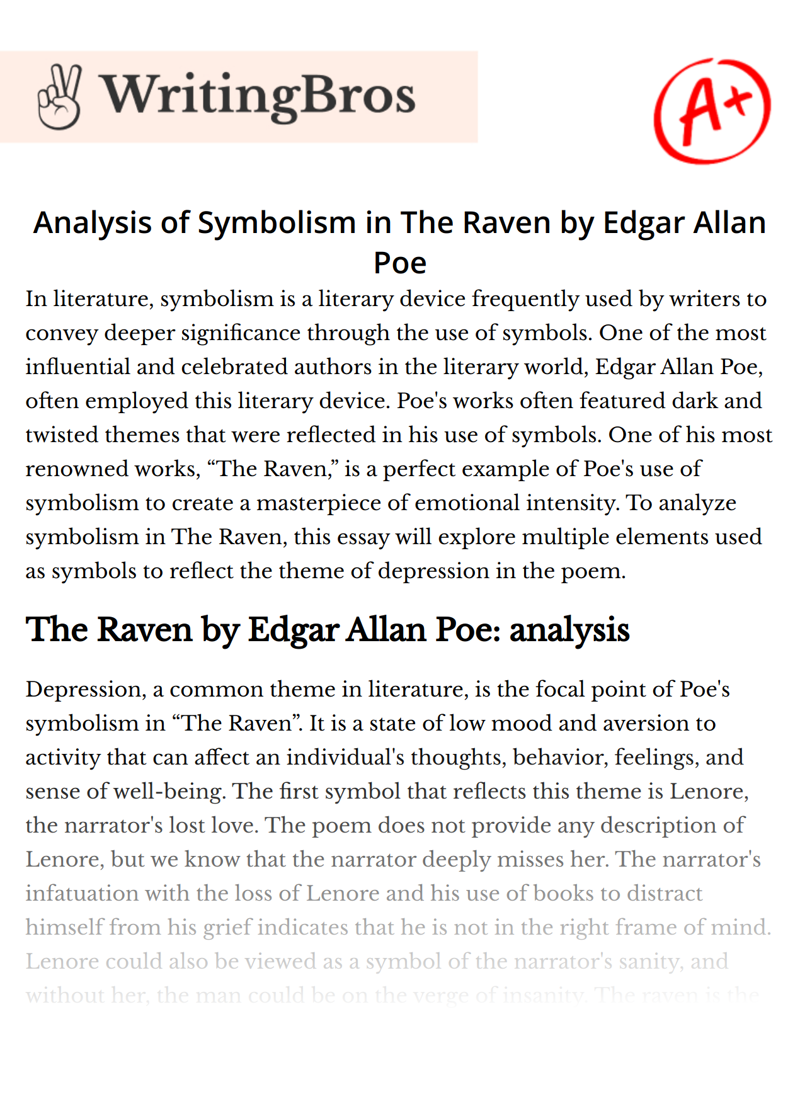Analysis of Symbolism in The Raven by Edgar Allan Poe

In literature, symbolism is a literary device frequently used by writers to convey deeper significance through the use of symbols. One of the most influential and celebrated authors in the literary world, Edgar Allan Poe, often employed this literary device. Poe's works often featured dark and twisted themes that were reflected in his use of symbols. One of his most renowned works, “The Raven,” is a perfect example of Poe's use of symbolism to create a masterpiece of emotional intensity. To analyze symbolism in The Raven, this essay will explore multiple elements used as symbols to reflect the theme of depression in the poem.
The Raven by Edgar Allan Poe: analysis
Depression, a common theme in literature, is the focal point of Poe's symbolism in “The Raven”. It is a state of low mood and aversion to activity that can affect an individual's thoughts, behavior, feelings, and sense of well-being. The first symbol that reflects this theme is Lenore, the narrator's lost love. The poem does not provide any description of Lenore, but we know that the narrator deeply misses her. The narrator's infatuation with the loss of Lenore and his use of books to distract himself from his grief indicates that he is not in the right frame of mind. Lenore could also be viewed as a symbol of the narrator's sanity, and without her, the man could be on the verge of insanity.
The raven is the most prominent symbol in “The Raven.” The bird's darkness symbolizes death, and its presence reminds the narrator of his current loneliness and the lonely future that awaits him. The raven's arrival leads the narrator to believe that it was sent from the Underworld, indicating that it is a mysterious creature that has come to him as a messenger of death. The raven serves as the primary source of the narrator's depression and becomes the symbol upon which the entire theme is built.
The bust of Pallas, the goddess of wisdom, is another symbol used in the poem. The raven perches on the goddess, leading the narrator to believe that the bird is speaking from wisdom and not just repeating its only line, “Nevermore.” The bust also signifies the knowledge of the man, portraying him as a wise and intelligent person who was not crazy to begin with. However, the raven's continued presence on the bust of Pallas creates a sense of fear and paranoia in the narrator, leading him to believe that his emotions and thoughts are becoming real.
The setting of the poem, the chamber, is used to signify the narrator's loneliness and sorrow for the loss of Lenore. The word “chamber” implies a cold, rigid feel, which suggests that the narrator has shut himself away from everything in order to be alone to brood and torture himself. The luxurious furnishings of the chamber serve as a reminder to the narrator of his lost love.
The storm is another symbol used in the poem to emphasize the isolation of the man. The contrast between the calmness in the chamber and the stormy night highlights the narrator's fear of being alone. The narrator's imagination runs wild as he hears the silken, sad, uncertain rustling of each purple curtain, which fills him with fantastic terrors he has never felt before.
In conclusion, Edgar Allan Poe's “The Raven” is a masterpiece of symbolism, with multiple elements used as symbols to reflect the theme of depression. Poe's use of symbolism adds depth to the poem, creating an emotional intensity that has captivated readers for generations. The symbolism in “The Raven” elevates the poem to the level of great literature and showcases Poe's mastery of the literary device.
References
- Poe, E. A. (1845). The Raven. The American Whig Review, 15(11), 1-6.
- Abu-Taieh, E., & Al-Jarrah, R. (2016). The use of symbols in Edgar Allan Poe's selected poems and short stories: A literary analysis study. International Journal of Humanities and Social Science Research, 6(1), 14-28.
- Barron, J. W. (1989). “The Raven” and the cult of melancholia. The Edgar Allan Poe Review, 1(1), 27-34.
- Buranelli, V. (1961). The Raven and the Nightingale. Modern Language Notes, 76(2), 113-121.
- Fleissner, R. F. (1995). The raven and the nightingale: Poe, Keats, and the traditions of poetic convention. Poetics Today, 16(4), 577-602.
- Gruesser, J. C. (1984). The talk of the raven: Poe's theory of composition as revealed in "The Philosophy of Composition". American Literature, 56(4), 549-562.
Cite this Essay
To export a reference to this article please select a referencing style below

